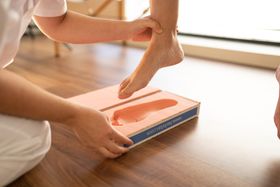Collapsed Arches vs. Flat Feet: How to Tell the Difference
Updated December 17, 2024.

Most people use the terms "collapsed arches" and "flat feet" interchangeably. While there are similarities between the two, there are also distinct differences.
A collapsed arch is a case of flat feet that develops in adulthood as a result of the weakening of the ligament that supports the arch or as a result of posterior tibial tendon dysfunction. On the other hand, flat feet begin in childhood and result in the improper formation of the foot arch.
Let’s consider the specific symptoms of the two types and how to distinguish one from the other.
Symptoms and Causes of Flat Feet
A flat foot is an abnormality that is present from birth. Often, it poses no problems and requires no treatment. However, complications may develop over time, leading to discomfort in the foot.
Possible symptoms of flat feet at this stage include your feet tiring easily, arch or heel pain, swollen feet, difficulty in moving the foot, and pain in the back and leg.
Symptoms and Causes of Collapsed Arches
A collapsed arch is sometimes referred to as an acquired flat foot because a flattened arch develops later in life. Some possible causes of collapsed arches include:
- Stretched or torn tendons
- Dysfunction of the posterior tibial tendon (either due to inflammation or damage)
- Broken or dislocated bones
- Health conditions like rheumatoid arthritis, or nerve problems
- Obesity, diabetes, aging, and pregnancy can also be contributing factors.
Symptoms of a collapsed arch include heel or arch pain like plantar fasciitis, problems standing on tiptoes, ankle swelling, a flat appearance of the feet, and uneven wearing of shoes.
» Wanting to treat your heel pain? Purchase a pair of Upstep's Custom Orthotics for Plantar Fasciitis
Signs of Collapsed Arches and Flat Feet
A diagnosis of collapsed arches or flat feet is easy to make. Signs to expect include pain in the foot, swelling, stiffness, and general difficulty in moving the foot. Pain may be restricted to the foot and ankle or spread to the calf, knee, thigh, hip, or spine.
By looking at how you stand or walk, your healthcare professional can easily observe if you have collapsed arches or flat feet. If the goal is to identify it yourself, wet your feet and see if the entire sole of your foot shows in your footprint on the floor or on paper after making contact with the ground.
Also, you can observe the pattern of wear in your shoes. Any unusual wear pattern may be indicative of a collapsed arch. Apart from this, pushing your big toes back as far as possible would normally cause the foot arch to appear; however, it does not in the case of a collapsed arch or flat foot.
Lastly, testing the strength of muscles and tendons, such as the Achilles tendon or the posterior tibial tendon, can help you determine what is functioning well and what isn’t.
Treating Collapsed Arches and Flat Feet
Most times, you don’t need treatment for collapsed arches or flat feet. However, if you have pain, stiffness, or experience other issues because of your feet, your healthcare provider will recommend a conservative treatment plan to manage the symptoms of flat feet and collapsed arches. This can include one or a combination of the following;
- Rest This is especially important when the cause of the collapsed arch is overuse. Getting off your feet will give them time to recover.
- Activity modification This could mean avoiding high impact sports like jumping and running.
- Weight loss If too much weight is being placed on the ankle and arches, it may force the arches to drop. Consequently, losing weight will reduce the weight being placed on the foot.
- Supportive footwear that fits well Shoes with a low heel and wide toe boxes are the best insoles for flat feet.
- Exercises for collapsed arches and flat feet Exercises that strengthen the right muscles in the arch of the foot, such as toe lifts and the towel scrunch, can help treat collapsed arches and flat feet.
- Physiotherapy This can be useful to correct compensatory gait patterns that tend to develop in instances of flat feet.
- Custom orthotics and arch support insoles These are useful when there is severe muscle weakness or nerve damage. Good custom orthotics and arch support insoles help cushion and support the feet, relieving pressure on the arch and preventing compensatory gait patterns. These are some of the many benefits of arch support.
If the conservative treatment fails to ease the symptoms, surgery is might be recommended. Surgical methods include bone fusion, removal of bony spurs, tendon enhancement, and bone grafting. The doctor will need to take a careful look at your medical history to determine how it started and what treatment method should be used.
» Take control of pain from flat feet today: Read our Flat Feet Orthotics review and get yourself a pair








